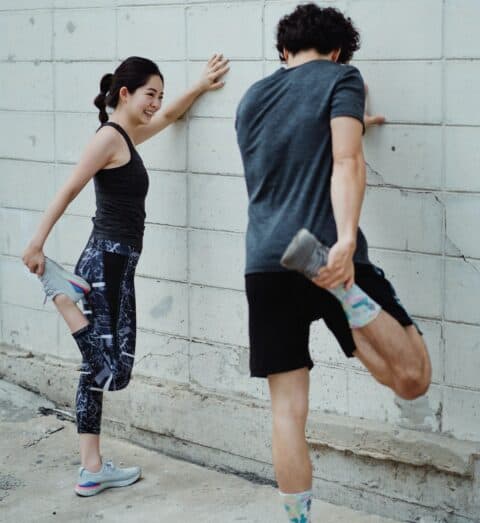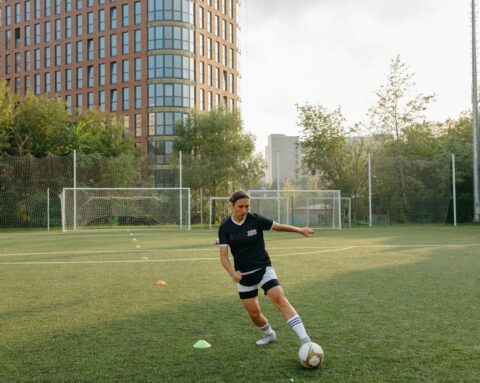Shin Splints is the term used to describe the pain felt alongside the front edges or the inside of the shin. They are the most common cause of painful shin bones and can be suffered as posterior or anterior shin splints. Shin splints can occur either as anterior or posterior. If your shin splints are anterior, then they will be found in the front of your shinbone. Posterior shin splints are observed on the inside back (posterior/medial) of your shin bone. ⠀⠀
Anterior:⠀
Your tibialis anterior is used to lower and raise your foot to assist in your stride. If you feel increased pain when lifting your toes whilst keeping your heels on the ground, you are likely suffering from anterior shin splints. ⠀
Posterior:⠀
Your tibialis posterior lifts and controls your foot arch as your body is weight-bearing. When posterior shin splints occur your foot arch will collapse which causes stress on your shin bone. Pain felt along the inside of your shin bone means you are most likely suffering from posterior shin splints.
Causes:
The most common cause of shin splints is overuse or overtraining associated with inadequate leg and foot biomechanics. There are several biomechanical and overtraining causes that are commonly seen in shin splints
Biomechanics Causes Can Include: ⠀
Over supination or pronation of your feet, tight muscles in your legs, weakness in your legs, poor control of your hip knee legs or buttocks, lower flexibility of your ankles. ⠀
Other extremely common causes from overtraining happen when you run on hard or angled surfaces, not having enough rest between exercise sets and increasing your training too quickly. Your shin pain will generally come from a combination of muscles, your tibia and Tenoperiosteum. Your muscles may become injured as a result of repeated overuse and excessive loading stress. You may experience inflammation, knots and tenderness. The most common muscles that cause shin splints are tibialis anterior and tibialis posterior.
Your periosteum is a hard shell that surrounds all of your bones. The muscles attach to the bone via a tendon which is attached to your periosteum. The point at which they meet is called the tenoperiosteum. When you have shin splints there will likely be some inflammation of the tenoperiosteum. ⠀
Additionally, if you are experiencing damage to your tibia (shin bone) it will most likely be mild. This can appear as a simple stress reaction. In some extreme cases, you may experience a severe stress fracture.
Symptoms:
There are three main symptoms associated with shin splints. ⠀
1. Your shin may be painful to touch.⠀
2. You may experience a dull, aching pain in the front of your lower leg. ⠀
3. You may feel shin pain on either side of your shinbone or in your muscles. ⠀
If you are experiencing heightened symptoms a bone scan or MRI may exclude or confirm a bone injury if your myotherapist or doctor need to investigate further.
Diagnosis:
Your myotherapist will diagnose your shin splints based on a physical examination and your medical history. Your myotherapist may need to use imaging technology or an X-ray to determine whether there are other causes for your pain. ⠀
If you leave your shin splints untreated and continue to overtrain they may progress into a tibial stress fracture! This can lead to 2 months away from your regular exercise routines.
Recovery:
In the initial phases of your shin splints, you may be unable to run or walk without feeling a lot of pain. ⠀
Your bones and shin muscles require rest from weight-bearing activities. As with most soft tissue injuries, Ice is a very effective form of treatment to reduce your swelling and pain. Apply the ice to the affected area in 2-4 hour blocks for 20 to 30 minutes at a time. In this initial stage of the injury, your myotherapist may recommend some supportive taping to provide some stress relief for your shin bone. It is best to avoid anti-inflammatory medications for the first 72 hours.
In the second and third phases of your recovery from shin splints, your myotherapist will assist you to regain your full range of motion and biomechanics. This period of the recovery may take several weeks as your strength and biomechanics will take some time to return. In this period, you should be ensuring that your scar tissue is remoulded optimally to prevent re-tears. Your myotherapist will guide you with specific exercises, stretches and mobilisation techniques. ⠀
In the third phase, your myotherapist will thoroughly assess your foot mechanics to determine whether you will require an orthotic for your feet or if you may require more intensive methods to normalise your biomechanics. As always, your myotherapist will advise you on the best option for your situation.
In the final two phases, your myotherapist will ensure that you have a proper modified plan to return to your exercise or sport of choice and that your muscle strength has returned. ⠀
Once all your effected leg muscles have been restored to full strength we will need to plan for a safe return to exercise. As shin splints occur commonly due to excessive training loads, we will need to ensure that your training schedule does not cause a recurrence. Your myotherapist will create a personal training program specific to your chose sport or exercise. By following your myotherapist’ advice you will be able to ensure a safe and injury-free return to your sport of choice. With the right program and discipline, you will be able to return to your sport with full function, agility, speed and power.
Your shin splints will progress from phase to phase due to many factors that will occur during your recovery. There is no set time frame to progress from one stage to another. Your myotherapist will guide you through your progress and ensure that your function improves whilst preventing setbacks. It is important to closely observe your exercise load and level of activity as progressing too soon can cause re-injury. ⠀
Booking sessions with your myotherapist is the best possible option for effectively managing your shin splint recovery!






